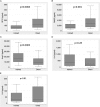Distinct molecular phenotypes of direct vs indirect ARDS in single-center and multicenter studies
- PMID: 26033126
- PMCID: PMC4451708
- DOI: 10.1378/chest.14-2454
Distinct molecular phenotypes of direct vs indirect ARDS in single-center and multicenter studies
Abstract
Background: ARDS is a heterogeneous syndrome that encompasses lung injury from both direct and indirect sources. Direct ARDS (pneumonia, aspiration) has been hypothesized to cause more severe lung epithelial injury than indirect ARDS (eg, nonpulmonary sepsis); however, this hypothesis has not been well studied in humans.
Methods: We measured plasma biomarkers of lung epithelial and endothelial injury and inflammation in a single-center study of 100 patients with ARDS and severe sepsis and in a secondary analysis of 853 patients with ARDS drawn from a multicenter randomized controlled trial. Biomarker levels in patients with direct vs indirect ARDS were compared in both cohorts.
Results: In both studies, patients with direct ARDS had significantly higher levels of a biomarker of lung epithelial injury (surfactant protein D) and significantly lower levels of a biomarker of endothelial injury (angiopoietin-2) than those with indirect ARDS. These associations were robust to adjustment for severity of illness and ARDS severity. In the multicenter study, patients with direct ARDS also had lower levels of von Willebrand factor antigen and IL-6 and IL-8, markers of endothelial injury and inflammation, respectively. The prognostic value of the biomarkers was similar in direct and indirect ARDS.
Conclusions: Direct lung injury in humans is characterized by a molecular phenotype consistent with more severe lung epithelial injury and less severe endothelial injury. The opposite pattern was identified in indirect lung injury. Clinical trials of novel therapies targeted specifically at the lung epithelium or endothelium may benefit from preferentially enrolling patients with direct and indirect ARDS, respectively.
Figures


References
-
- Ware LB, Matthay MA. The acute respiratory distress syndrome. N Engl J Med. 2000;342(18):1334-1349. - PubMed
-
- Menezes SL, Bozza PT, Neto HC, et al. Pulmonary and extrapulmonary acute lung injury: inflammatory and ultrastructural analyses. J Appl Physiol (1985). 2005;98(5):1777-1783. - PubMed
-
- Pelosi P, D’Onofrio D, Chiumello D, et al. Pulmonary and extrapulmonary acute respiratory distress syndrome are different. Eur Respir J. 2003;22(suppl 42):48s-56s. - PubMed
-
- Bernard GR, Artigas A, Brigham KL, et al. The American-European Consensus Conference on ARDS. Definitions, mechanisms, relevant outcomes, and clinical trial coordination. Am J Respir Crit Care Med. 1994;149(3):818-824. - PubMed
-
- Gattinoni L, Pelosi P, Suter PM, Pedoto A, Vercesi P, Lissoni A. Acute respiratory distress syndrome caused by pulmonary and extrapulmonary disease. Different syndromes? Am J Respir Crit Care Med. 1998;158(1):3-11. - PubMed
Publication types
MeSH terms
Substances
Grants and funding
- HL103836/HL/NHLBI NIH HHS/United States
- HL51856/HL/NHLBI NIH HHS/United States
- KL2 TR000143/TR/NCATS NIH HHS/United States
- HL090833/HL/NHLBI NIH HHS/United States
- N01-HR-16146-54/HR/NHLBI NIH HHS/United States
- N01 HR016146/HR/NHLBI NIH HHS/United States
- HL110969/HL/NHLBI NIH HHS/United States
- 1K23 HL116800-01/HL/NHLBI NIH HHS/United States
- R01 HL051856/HL/NHLBI NIH HHS/United States
- K24 HL103836/HL/NHLBI NIH HHS/United States
- R37 HL051856/HL/NHLBI NIH HHS/United States
- N01-HR-46046-64/HR/NHLBI NIH HHS/United States
- K23 HL116800/HL/NHLBI NIH HHS/United States
- T32 HL087738/HL/NHLBI NIH HHS/United States
- HL112656/HL/NHLBI NIH HHS/United States
- R21 HL112656/HL/NHLBI NIH HHS/United States
- K23 HL090833/HL/NHLBI NIH HHS/United States
- R01 HL110969/HL/NHLBI NIH HHS/United States
LinkOut - more resources
Full Text Sources
Other Literature Sources
Medical

